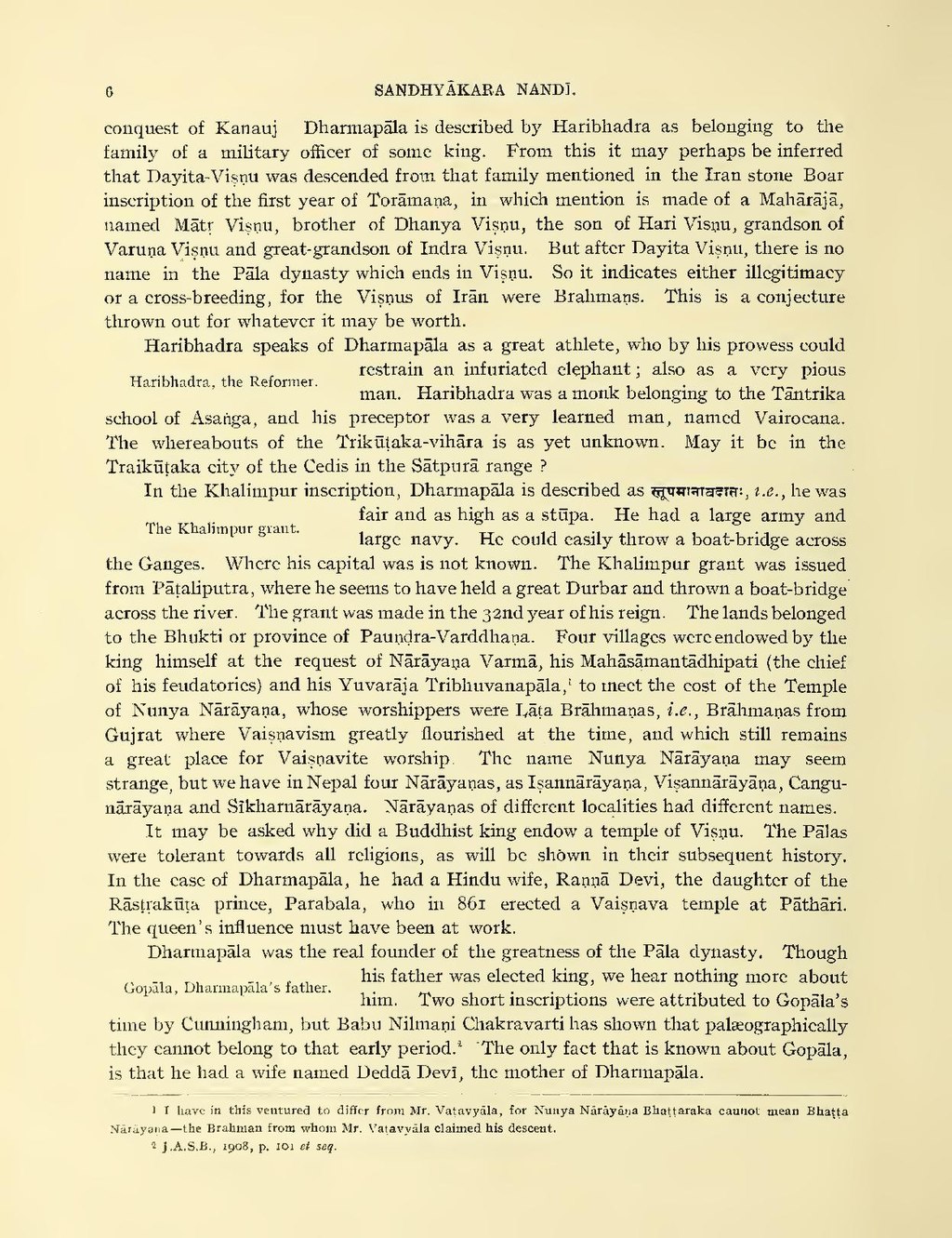SANDHYAKARA NANDI. conquest of Kanauj Dharmapala is described by Haribhadra as belonging to the family of a military officer of some king. From this it may perhaps be inferred that Dayita-Visņu was descended from that family mentioned in the Iran stone Boar inscription of the first year of Torāmaṇa, in which mention is made of a Mahārājā, named Matr Visnu, brother of Dhanya Visņu, the son of Hari Visņu, grandson of Varuna Vișnu and great-grandson of Indra Visņu. But after Dayita Vișņu, there is no name in the Pala dynasty which ends in Visņu. So it indicates either illegitimacy or a cross-breeding, for the Vișnus of Iran were Brahmans. This is a conjecture thrown out for whatever it may be worth. Haribhadra speaks of Dharmapala as a great athlete, who by his prowess could restrain an infuriated elephant; also as a very pious Haribhadra, the Reformer. man. Haribhadra was a monk belonging to the Tantrika school of Asanga, and his preceptor was a very learned man, named Vairocana. The whereabouts of the Trikūṭaka-vihāra is as yet unknown. May it be in the Traikutaka city of the Cedis in the Satpura range ? The Khalimpur grant. In the Khalimpur inscription, Dharmapāla is described as quaera:, 1.e., he was fair and as high as a stūpa. He had a large army and large navy. He could casily throw a boat-bridge across the Ganges. Where his capital was is not known. The Khalimpur grant was issued from Pāṭaliputra, where he seems to have held a great Durbar and thrown a boat-bridge across the river. The grant was made in the 32nd year of his reign. The lands belonged to the Bhukti or province of Pauṇḍra-Varddhaṇa. Four villages were endowed by the king himself at the request of Nārāyaṇa Varmā, his Mahāsāmantadhipati (the chief of his feudatories) and his Yuvarāja Tribhuvanapala, to inect the cost of the Temple of Nunya Nārāyaṇa, whose worshippers were Lata Brāhmaṇas, i.e., Brāhmaṇas from Gujrat where Vaiṣṇavism greatly flourished at the time, and which still remains a great place for Vaisnavite worship. The name Nunya Narayana may seem strange, but we have in Nepal four Nārāyaṇas, as Iṣannārāyaṇa, Viṣannārāyāṇa, Cangu- nārāyaṇa and Sikharnārāyaṇa. Nārāyaṇas of different localities had different names. 6 It may be asked why did a Buddhist king endow a temple of Visņu. The Palas were tolerant towards all religions, as will be shown in their subsequent history. In the case of Dharmapala, he had a Hindu wife, Ranna Devi, the daughter of the Rastrakūta prince, Parabala, who in 861 erected a Vaiṣṇava temple at Pathari. The queen's influence must have been at work. Dharmapala was the real founder of the greatness of the Pāla dynasty. Though his father was elected king, we hear nothing more about Gopala, Dharmapala's father. him. Two short inscriptions were attributed to Gopala's time by Cunningham, but Babu Nilmani Chakravarti has shown that palæographically they cannot belong to that early period. The only fact that is known about Gopala, is that he had a wife named Dedda Devi, the mother of Dharmapala. I have in this ventured to differ from Mr. Vatavyāla, for Nunya Narayana Bhattaraka caunot mean Bhatta Narayana the Brahman from whom Mr. Vatavyāla claimed his descent. 2 J.A.S.B., 1908, p. 101 et seq.

